Design for Success
Getting Your Design Fab Ready
"Design for Manufacture" is the process of designing something that can be built at scale.
Sure, you need to think through what you're going to build and how, but once you've done that, it's easy to make copies. That's what computers do.
When you're building a physical product however, there are many more variables. For example, the materials used to build a product may have slight variations from one batch to another. This is why manufacturers will often test a few products off the production line and make small adjustments based on those results.
Sometimes these problems can be resolved by designing the product differently, or by choosing different materials or components. And sometimes they can't. If they can't, then either the customer gets a lower quality product, which is bad for business, or the manufacturer has to spend more time and money on QA and fixing problems before shipping them out.
This is why design for manufacture matters so much in hardware; it saves time and money while improving quality.
With “Design for Manufacture” as a cornerstone tenet, Redclay Semi can help your company grow their product to manufacture at scale.
FV, Proto, Layout
It all begins with an idea.
The essence of engineering is to take a problem and break it down into smaller problems until you have solved them all. That's why the most important part of learning to program is learning to use a debugger.
In hardware design, there are several key steps in the process:
Verification - Make sure your design is correct by modeling the design using a high level language such as SystemVerilog or Specman e and using simulation or formal verification tools to verify it.
Prototyping - Ensure your design works by building an FPGA prototype using tools from Altera, Xilinx, or others.
Layout - Build the physical layout of your chip using Cadence Virtuoso, Mentor Calibre, Synopsys Design Compiler, etc.
Traditionally this has been a slow and painstaking process, but the design world has changed.
We now have the compute power for the cloud to run massive simulations, formal verification, and FPGA prototyping in minutes.
We can do more than before - more algorithms, more execution paths, more software integration.
Talk with us to see if one of our industry leading partners can help ease the cycle for you with powerful cloud-compute solutions.


